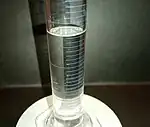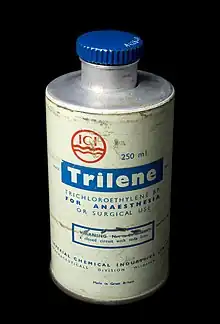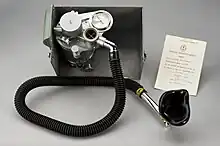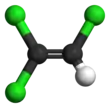Trichloroethylene
Trichloroethylene (TCE) is a halocarbon with the formula C2HCl3, commonly used as an industrial degreasing solvent. It is a clear, colourless non-flammable liquid with a chloroform-like pleasant and pungent smell.[5] The IUPAC name is trichloroethene. Industrial abbreviations include TCE, trichlor, Trike, Tricky and tri. It should not be confused with the similar 1,1,1-trichloroethane, which is commonly known as chlorothene.
 | |||
| |||
 sample of Trichloroethylene | |||
| Names | |||
|---|---|---|---|
| Preferred IUPAC name
Trichloroethene | |||
| Other names
1-Chloro-2,2-Dichloroethylene; 1,1-Dichloro-2-Chloroethylene; Acetylene Trichloride; Anamenth; HCC-1120; TCE; Trethylene; Triclene; Tri; Trico; Trilene; Trimar; UN 1710 | |||
| Identifiers | |||
3D model (JSmol) |
|||
| Abbreviations | TCE | ||
| ChEBI | |||
| ChEMBL | |||
| ChemSpider | |||
| ECHA InfoCard | 100.001.062 | ||
| EC Number |
| ||
| KEGG | |||
PubChem CID |
|||
| RTECS number |
| ||
| UNII | |||
CompTox Dashboard (EPA) |
|||
| |||
| |||
| Properties | |||
| C2HCl3 | |||
| Molar mass | 131.38 g/mol | ||
| Appearance | Colorless liquid | ||
| Odor | pleasant and pungent, chloroform- and acetone-like | ||
| Density | 1.46 g/cm3 at 20 °C | ||
| Melting point | −84.8 °C (−120.6 °F; 188.3 K)[1] | ||
| Boiling point | 87.2 °C (189.0 °F; 360.3 K)[2] | ||
| 1.280 g/L[3] | |||
| Solubility | Ether, ethanol, chloroform | ||
| log P | 2.26[4] | ||
| Vapor pressure | 58 mmHg (0.076 atm) at 20 °C[5] | ||
| −65.8·10−6 cm3/mol | |||
Refractive index (nD) |
1.4777 at 19.8 °C | ||
| Viscosity | 0.532 mPa·s[6] | ||
| Pharmacology | |||
| N01AB05 (WHO) | |||
| Hazards | |||
| Occupational safety and health (OHS/OSH): | |||
Main hazards |
carcinogenic, neurotoxic, hepatotoxic | ||
| GHS labelling: | |||

| |||
| NFPA 704 (fire diamond) | |||
| 420 °C (788 °F; 693 K) | |||
| Explosive limits | 8-10.5%[5] | ||
| Lethal dose or concentration (LD, LC): | |||
LD50 (median dose) |
4920 mg/kg (oral, rat), 29000 mg/kg (dermal, rabbit)[7] | ||
LC50 (median concentration) |
8450 ppm (mouse, 4 hr) 26300 (rat, 1 hr)[8] | ||
LCLo (lowest published) |
2900 ppm (human) 37,200 ppm (guinea pig, 40 min) 5952 ppm (cat, 2 hr) 8000 ppm (rat, 4 hr) 11,000 (rabbit)[8] | ||
| NIOSH (US health exposure limits): | |||
PEL (Permissible) |
TWA 100 ppm C 200 ppm 300 ppm (5-minute maximum peak in any 2 hours)[5] | ||
REL (Recommended) |
Ca[5] | ||
IDLH (Immediate danger) |
Ca [1000 ppm][5] | ||
| Safety data sheet (SDS) | Mallinckrodt Baker | ||
| Legal status | |||
| Related compounds | |||
Related vinyl halides |
Vinyl chloride | ||
Related compounds |
Chloroform 1,1,1-Trichloroethane 1,1,2-Trichloroethane Tetrachloroethylene | ||
| Supplementary data page | |||
| Trichloroethylene (data page) | |||
Except where otherwise noted, data are given for materials in their standard state (at 25 °C [77 °F], 100 kPa).
Infobox references | |||
Trichloroethylene has been sold under a variety of trade names. Under the trade names Trimar and Trilene, it was used as a volatile anesthetic and as an inhaled obstetrical analgesic in millions of patients.
Groundwater and drinking water contamination from industrial discharge including trichloroethylene is a major concern for human health and has precipitated numerous incidents and lawsuits in the United States.
History
The earliest record of trichloroethylene synthesis dates back to 1836. It was obtained from the action of potassium hydroxide on 1,1,2,2-Tetrachloroethane and 1,1,1,2-Tetrachloroethane by Auguste Laurent and notated as C4HCl3 (then the atomic weight of carbon was thought to be the half of it actually was). Laurent did not investigate the compound further.[10][11]
Trichloroethylene's discovery is widely attributed to E. Fischer who made it in 1864 via reduction of hexachloroethane with hydrogen, Fischer investigated TCE and noted its boiling point as between 87 and 90 degrees Celsius.[12][13][14] Commercial production began in Germany, in 1920 and in the US in 1925.[15]
Pioneered by Imperial Chemical Industries in Britain, its development was hailed as an anesthetic revolution. Originally thought to possess less hepatotoxicity than chloroform, and without the unpleasant pungency and flammability of ether, TCE use was nonetheless soon found to have several pitfalls. These included promotion of cardiac arrhythmias, low volatility and high solubility preventing quick anesthetic induction, reactions with soda lime used in carbon dioxide absorbing systems, prolonged neurologic dysfunction when used with soda lime, and evidence of hepatotoxicity as had been found with chloroform.
The introduction of halothane in 1956 greatly diminished the use of TCE as a general anesthetic. TCE was still used as an inhalation analgesic in childbirth given by self-administration. Fetal toxicity and concerns for carcinogenic potential of TCE led to its abandonment in developed countries by the 1980s.
The use of trichloroethylene in the food and pharmaceutical industries has been banned in much of the world since the 1970s due to concerns about its toxicity. Legislation has forced the replacement of trichloroethylene in many processes in Europe as the chemical was classified as a carcinogen carrying an R45 risk phrase, May cause cancer. Many degreasing chemical alternatives are being promoted such as Ensolv and Leksol; however, each of these is based on n-propyl bromide which carries an R60 risk phrase of May impair fertility, and they would not be a legally acceptable substitute.
Production
Prior to the early 1970s, most trichloroethylene was produced in a two-step process from acetylene. First, acetylene was treated with chlorine using a ferric chloride catalyst at 90 °C to produce 1,1,2,2-tetrachloroethane according to the chemical equation:
- HC≡CH + 2 Cl2 → Cl2CHCHCl2
The 1,1,2,2-tetrachloroethane is then dehydrochlorinated to give trichloroethylene. This can be accomplished either with an aqueous solution of calcium hydroxide:
or in the vapor phase by heating it to 300–500 °C on a barium chloride or calcium chloride catalyst:
- Cl2CHCHCl2 → ClCH=CCl2 + HCl
Today, however, most trichloroethylene is produced from ethylene. First, ethylene is chlorinated over a ferric chloride catalyst to produce 1,2-dichloroethane:
- CH2=CH2 + Cl2 → ClCH2CH2Cl
When heated to around 400 °C with additional chlorine, 1,2-dichloroethane is converted to trichloroethylene:
- ClCH2CH2Cl + 2 Cl2 → ClCH=CCl2 + 3 HCl
This reaction can be catalyzed by a variety of substances. The most commonly used catalyst is a mixture of potassium chloride and aluminum chloride. However, various forms of porous carbon can also be used. This reaction produces tetrachloroethylene as a byproduct and depending on the amount of chlorine fed to the reaction, tetrachloroethylene can even be the major product. Typically, trichloroethylene and tetrachloroethylene are collected together and then separated by distillation.
Uses
Trichloroethylene is an effective solvent for a variety of organic materials.
When it was first widely produced in the 1920s, trichloroethylene's major use was to extract vegetable oils from plant materials such as soy, coconut, and palm. Other uses in the food industry included coffee decaffeination and the preparation of flavoring extracts from hops and spices.
Dehydrochlorination of trichloroethylene with potassium hydride gives dichloroacetylene.[16]
Anaesthesia


Trichloroethylene is a good analgesic at 0.35 to 0.5% concentrations.[17] From the 1930s through the 1970s, both in Europe and in North America, trichloroethylene was used as a volatile anesthetic almost invariably administered with nitrous oxide. Marketed in the UK by Imperial Chemical Industries under the trade name Trilene it was coloured blue (with a dye called waxoline blue in 1:200,000 concentration)[18] to avoid confusion with the similar-smelling chloroform. Trilene was stabilised with 0.01% thymol.[18]
TCE replaced earlier anesthetics chloroform and ether in the 1940s, but was itself replaced in the 1960s in developed countries with the introduction of halothane, which allowed much faster induction and recovery times and was considerably easier to administer. Trilene was also used as an inhaled analgesic, mainly during childbirth, often self-applied by the patient. Trichloroethylene was introduced for obstetrical anaesthesia in 1943, used until the 1980s.[17]
It was used with halothane in the Tri-service field anaesthetic apparatus used by the UK armed forces under field conditions. As of 2000, however, TCE was still in use as an anesthetic in Africa.[19]
Trichloroethylene has been used in the production of halothane, another anaesthetic.[20]
Cleaning solvent
It has also been used as a dry cleaning solvent, although replaced in the 1950s by tetrachloroethylene (also known as perchloroethylene), except for spot cleaning where it is still used under the trade name Picrin.
Perhaps the greatest use of TCE has been as a degreaser for metal parts. The demand for TCE as a degreaser began to decline in the 1950s in favor of the less toxic 1,1,1-trichloroethane. However, 1,1,1-trichloroethane production has been phased out in most of the world under the terms of the Montreal Protocol, and as a result trichloroethylene has experienced some resurgence in use as a degreaser.
TCE has also been used in the United States to clean kerosene-fueled rocket engines (TCE was not used to clean hydrogen-fueled engines such as the Space Shuttle Main Engine). During static firing, the RP-1 fuel would leave hydrocarbon deposits and vapors in the engine. These deposits had to be flushed from the engine to avoid the possibility of explosion during engine handling and future firing. TCE was used to flush the engine's fuel system immediately before and after each test firing. The flushing procedure involved pumping TCE through the engine's fuel system and letting the solvent overflow for a period ranging from several seconds to 30–35 minutes, depending upon the engine. For some engines, the engine's gas generator and liquid oxygen (LOX) dome were also flushed with TCE prior to test firing.[21][22] The F-1 rocket engine had its LOX dome, gas generator, and thrust chamber fuel jacket flushed with TCE during launch preparations.[22]
Refrigerants
TCE is also used in the manufacture of a range of fluorocarbon refrigerants[23] such as 1,1,1,2-tetrafluoroethane more commonly known as HFC 134a. TCE was also used in industrial refrigeration applications due to its high heat transfer capabilities and its low-temperature specification.
Safety
Chemical instability
Despite its widespread use as a metal degreaser, trichloroethylene itself is unstable in the presence of metal over prolonged exposure. As early as 1961 this phenomenon was recognized by the manufacturing industry, when stabilizing additives were added to the commercial formulation. Since the reactive instability is accentuated by higher temperatures, the search for stabilizing additives was conducted by heating trichloroethylene to its boiling point in a reflux condenser and observing decomposition. Definitive documentation of 1,4-dioxane as a stabilizing agent for TCE is scant due to the lack of specificity in early patent literature describing TCE formulations.[24][25] Epichlorohydrin, butylene oxide, methyl pyrrole and ethyl acetate are commonly used as stabilisers in TCE, with epichlorohydrin being the most persistent.[26] Other chemical stabilizers include ketones such as methyl ethyl ketone.
Physiological effects
When inhaled, trichloroethylene produces central nervous system depression resulting in general anesthesia. These effects may be mediated by trichloroethylene acting as a positive allosteric modulator of inhibitory GABAA and glycine receptors.[27][28] Its high blood solubility results in a less desirable slower induction of anesthesia. At low concentrations it is relatively non-irritating to the respiratory tract. Higher concentrations result in tachypnea. Many types of cardiac arrhythmias can occur and are exacerbated by epinephrine (adrenaline). It was noted in the 1940s that TCE reacted with carbon dioxide (CO2) absorbing systems (soda lime) to produce dichloroacetylene and phosgene.[29] Cranial nerve dysfunction (especially the fifth cranial nerve) was common when TCE anesthesia was given using CO2 absorbing systems. Muscle relaxation with TCE anesthesia sufficient for surgery was poor. For these reasons as well as problems with hepatotoxicity, TCE lost popularity in North America and Europe to more potent anesthetics such as halothane by the 1960s.[30]
The symptoms of acute non-medical exposure are similar to those of alcohol intoxication, beginning with headache, dizziness, and confusion and progressing with increasing exposure to unconsciousness.[31]
Much of what is known about the human health effects of trichloroethylene is based on occupational exposures. Beyond the effects to the central nervous system, workplace exposure to trichloroethylene has been associated with toxic effects in the liver and kidney.[31]
Exposure and regulations
TCE levels above background have been found in homes undergoing renovation.[32] With a specific gravity greater than 1 (denser than water), trichloroethylene can be present as a dense non-aqueous phase liquid (DNAPL) if sufficient quantities are spilled in the environment.
The first known report of TCE in groundwater was given in 1949 by two English public chemists who described two separate instances of well contamination by industrial releases of TCE.[33] Based on available federal and state surveys, between 9% and 34% of the drinking water supply sources tested in the US may have some TCE contamination, though EPA has reported that most water supplies are in compliance with the maximum contaminant level (MCL) of 5 ppb.[34]
Generally, atmospheric levels of TCE are highest in areas of concentrated industry and population. Atmospheric levels tend to be lowest in rural and remote regions. Average TCE concentrations measured in air across the United States generally between 0.01 ppb and 0.3 ppb, although mean levels as high as 3.4 ppb have been reported.[35] TCE levels in the low parts per billion range have been measured in food; however, levels as high as 140 ppb were measured in a few samples of food.[35]
Existing regulation in the United States and European Union
Until recent years, the US Agency for Toxic Substances and Disease Registry (ATSDR) contended that trichloroethylene had little-to-no carcinogenic potential and was probably a co-carcinogen—that is, it acted in concert with other substances to promote the formation of tumors.
State, federal, and international agencies classify trichloroethylene as a known or probable carcinogen. In 2014, the International Agency for Research on Cancer updated its classification of trichloroethylene to Group 1, indicating that sufficient evidence exists that it causes cancer of the kidney in humans as well as some evidence of cancer of the liver and non-Hodgkin's lymphoma.[36]
In the European Union, the Scientific Committee on Occupational Exposure Limit Values (SCOEL) recommends an exposure limit for workers exposed to trichloroethylene of 10 ppm (54.7 mg/m3) for 8-hour TWA and of 30 ppm (164.1 mg/m3) for STEL (15 minutes).[37]
Existing EU legislation aimed at protection of workers against risks to their health (including Chemical Agents Directive 98/24/EC[38] and Carcinogens Directive 2004/37/EC[39]) currently do not impose binding minimum requirements for controlling risks to workers' health during the use phase or throughout the life cycle of trichloroethylene.
In 2023, the United States EPA determined that trichloroethylene presents an unreasonable risk of injury to human health under 52 out of 54 conditions of use, including during manufacturing, processing, mixing, recycling, vapor degreasing, as a lubricant, adhesive, sealant, cleaning product, and spray. It is dangerous from both inhalation and dermal exposure and was most strongly associated with immunosuppressive effects for acute exposure, as well as autoimmune effects for chronic exposures. [40]
As of June 1, 2023, two U.S. states (Minnesota and New York) have acted on the EPA's findings and banned trichloroethylene in all cases but research and development.[41][42]
Remediation
Recent research has focused on the in-place remediation of trichloroethylene in soil and ground water instead of removal for off-site treatment and disposal. Naturally occurring bacteria have been identified with the ability to degrade TCE. Dehalococcoides sp. degrade trichloroethylene by reductive dechlorination under anaerobic conditions. Under aerobic conditions, Pseudomonas fluorescens can co-metabolize TCE. Soil and ground water contamination by TCE has also been successfully remediated by chemical treatment and extraction. The bacteria Nitrosomonas europaea can degrade a variety of halogenated compounds including trichloroethylene.[43] Toluene dioxygenase has been reported to be involved in TCE degradation by Pseudomonas putida.[44] In some cases, Xanthobacter autotrophicus can convert up to 51% of TCE to CO and CO2.[44]
Society and culture
The 1995 non-fiction book A Civil Action was written about a lawsuit (Anderson v. Cryovac) against following the increase in cancer cases after trichloroethylene pollution incidents and it was adapted to cinema in 1998.
References
- "Safety Data Sheet". Retrieved 23 February 2022.
- Trichloroethylene in the ChemIDplus database
- "Trichloroethylene". Sigmaaldrich.com. Retrieved 20 October 2014.
- "Trichloroethylene". www.chemsrc.com.
- NIOSH Pocket Guide to Chemical Hazards. "#0629". National Institute for Occupational Safety and Health (NIOSH).
- Venkatesulu, D.; Venkatesu, P.; Rao, M. V. Prabhakara (1997). "Viscosities and Densities of Trichloroethylene or Tetrachloroethylene with 2-Alkoxyethanols at 303.15 K and 313.15 K". Journal of Chemical & Engineering Data. 42 (2): 365–367. doi:10.1021/je960316f. ISSN 0021-9568.
- FischerSci Trichloroethylene SDS
- "Trichloroethylene". Immediately Dangerous to Life or Health Concentrations (IDLH). National Institute for Occupational Safety and Health (NIOSH).
- Anvisa (2023-03-31). "RDC Nº 784 - Listas de Substâncias Entorpecentes, Psicotrópicas, Precursoras e Outras sob Controle Especial" [Collegiate Board Resolution No. 784 - Lists of Narcotic, Psychotropic, Precursor, and Other Substances under Special Control] (in Brazilian Portuguese). Diário Oficial da União (published 2023-04-04). Archived from the original on 2023-08-03. Retrieved 2023-08-16.
- Essai sur l'Action du Chlore sur la Liqueur des Hollandais et sur quelques Ethers in Annal. de Chimie, LXIII. (1836) page 379
- The so-called Perchloride of Formyl, Gmelin, L. (translated in 1855). Hand-book of Chemistry: Organic chemistry. UK: Cavendish Society. pages 200–201
- Ueber die Einwirkung von Wasserstoff auf Einfach-Chlorkohlenstoff, Fischer, E. (1864) in Zeitschrift für Chemie. page 268
- Waters EM, Gerstner HB, Huff JE. Trichloroethylene. I. An overview. J Toxicol Environ Health. 1977 Jan;2(3):671-707. doi: 10.1080/15287397709529469. PMID 403297.
- Hardie DWF (1964). Chlorocarbons and chlorohydrocarbons. 1,1,2,2-Tetrachloroethane. In: Encyclopedia of Chemical Technology. Kirk RE, Othmer DF, editors. New York: John Wiley & Sons, pp. 159–164
- Mertens JA (1993). Chlorocarbons and chlorohydrocarbons. In: Kirk-Othmer Encyclopedia of Chemical Technology, 4th Ed. Kroschwitz JI, Howe-Grant M, editors. New York: John Wiley & Sons, pp. 40–50.
- Denis, Jean Noel; Moyano, Albert; Greene, Andrew E. (1987). "Practical synthesis of dichloroacetylene". The Journal of Organic Chemistry. 52 (15): 3461–3462. doi:10.1021/jo00391a059.
- Textbook of Obstetric Anaesthesia. (2002). UK: Greenwich Medical Media. Pages 64-65
- Current Researches in Anesthesia & Analgesia. (1951). USA: International Anesthesia Research Society. p.278
- P. Fenton (2000). "Volatile Anaesthetic Agents". Archived from the original on 2012-01-07. Retrieved 2012-02-11.
- Suckling et al.,"PROCESS FOR THE PREPARATION OF 1,1,1-TRIFLUORO-2-BROMO-2-CHLOROETHANE", US patent 2921098, granted January 1960 , assigned to Imperial Chemical Industries
- "Santa Susana Field Laboratory : The Use of Trichloroethylene at NASA's SSFL Sites" (PDF). Ssfl.msfc.nasa.gov. Archived from the original (PDF) on 14 November 2013. Retrieved 22 February 2015.
- "F-1 Rocket Engine Operating Instructions". Ntrs.nasa.gov. Retrieved 20 October 2014.
- "Production of R-134a" (PDF). Nd.edu. Archived from the original (PDF) on 11 July 2009. Retrieved 21 February 2015.
- Murphy, Brian L; Morrison, Robert D. (2015). "9. Source Identification and Age Dating of Chlorinated Solvents". Introduction to environmental forensics (3rd ed.). Academic Press. sec. 9.2.2.1 1,4-Dioxane. ISBN 978-0124047075.
- Mohr, Thomas K. G. (2010). "Historical Use of Chlorinated Solvents and Their Stabilizing Compounds". Environmental investigation and remediation: 1,4-dioxane and other solvent stabilizers. CRC Press. p. 53 "Was 1,4-Dioxane a Stabilizer for Trichloroethylene?". ISBN 978-1566706629.
- Morrison, R. D., Murphy, B. L. (2013). Chlorinated Solvents: A Forensic Evaluation. UK Royal Society of Chemistry.
- M. J. Beckstead, J. L. Weiner, E. I. 2nd Eger, D. H. Gong & S. J. Mihic (2000). "Glycine and gamma-aminobutyric acid(A) receptor function is enhanced by inhaled drugs of abuse". Molecular Pharmacology. 57 (6): 1199–1205. PMID 10825391.
{{cite journal}}: CS1 maint: multiple names: authors list (link) - M. D. Krasowski & N. L. Harrison (2000). "The actions of ether, alcohol and alkane general anaesthetics on GABAA and glycine receptors and the effects of TM2 and TM3 mutations". British Journal of Pharmacology. 129 (4): 731–743. doi:10.1038/sj.bjp.0703087. PMC 1571881. PMID 10683198.
- Orkin, F. K. (1986) Anesthesia Systems (Chapter 5). In R. D. Miller (Ed.), Anesthesia (second edition). New York, NY: Churchill Livingstone.
- Stevens, W.C. and Kingston H. G. G. (1989) Inhalation Anesthesia (Chapter 11). In P. G. Barash et al. (Eds.) Clinical Anesthesia. Philadelphia, PA: Lippincott.
- "Trichloroethylene | Technology Transfer Network Air Toxics Web site | US EPA". Epa.gov. Retrieved 2013-10-05.
- "Trichloroethylene (tce) TEACH Chemical Summary - epa nepis".
- Lyne FA, McLachlan T (1949). "Contamination of water by trichloroethylene" p. 513 in Lilliman, B.; Houlihan, J. E.; Lyne, F. A.; McLachlan, T. (1949). "Notes". The Analyst. 74 (882): 510–513. Bibcode:1949Ana....74..510L. doi:10.1039/AN9497400510.
- "Consumer Factsheet on: Trichloroethylene" (PDF). Epa.gov. Retrieved 22 February 2015.
- "Trichloroethylene Toxicity: Where is Trichloroethylene Found? | Environmental Medicine | ATSDR". www.atsdr.cdc.gov. 2022-09-09. Retrieved 2023-03-02.
 This article incorporates text from this source, which is in the public domain.
This article incorporates text from this source, which is in the public domain. - Trichloroethylene (IARC Summary & Evaluation, Volume 106, 2014) (PDF). iarc.fr. Retrieved 2016-03-08.
- "Recommendation from the Scientific Committee on Occupational Exposure Limits for Trichloroethylene (SCOEL/SUM/142)" (PDF). April 2009.
- "Council Directive 98/24/EC" (PDF). Eur-lex.europa.eu. Retrieved 21 February 2015.
- "Directive 2004/37/EC" (PDF). Eur-lex.europa.eu. Retrieved 21 February 2015.
- US EPA, OCSPP (2020-02-12). "Final Risk Evaluation for Trichloroethylene" (PDF). www.epa.gov. Retrieved 2023-06-03.
- "How Minnesota passed the country's first ban on trichloroethylene". www.pca.state.mn.us/news-and-stories. Minnesota Pollution Control Agency. 28 August 2023. Archived from the original on 6 September 2023. Retrieved 6 September 2023.
- "Minnesota Statutes". Environmental Protection, Chapter 116, Section 116.385, act No. 116.38 (also known as "White Bear Area Neighborhood Concerned Citizens Group Ban TCE Act") of 2022. Minnesota Legislature. Archived from the original on 6 September 2023.
- "Nitrosomonas europaea". Genome.jgi-psf.org. 2015-02-05. Archived from the original on 2009-07-03. Retrieved 2015-02-21.
- Robert L. Irvine; Subhas K. Sikdar (1998). Bioremediation Technologies: Principles and Practice. CRC Press. pp. 142, 144. ISBN 978-1566765619. Retrieved 21 February 2015.
Further reading
- Agency for Toxic Substances and Disease Registry (ATSDR). 1997. Toxicological Profile for Trichloroethylene.
- Doherty, Richard E. (2000). "A History of the Production and Use of Carbon Tetrachloride, Tetrachloroethylene, Trichloroethylene and 1,1,1-Trichloroethane in the United States: Part 2 – Trichloroethylene and 1,1,1-Trichloroethane". Environmental Forensics. 1 (2): 83–93. doi:10.1006/enfo.2000.0011. S2CID 97370778.
- Lipworth, Loren; Tarone, Robert E.; McLaughlin, Joseph K. (2006). "The Epidemiology of Renal Cell Carcinoma". The Journal of Urology. 176 (6): 2353–2358. doi:10.1016/j.juro.2006.07.130. PMID 17085101.
- US Environmental Protection Agency (USEPA). 2011. Toxicological Review for Trichloroethylene
- US National Academy of Sciences (NAS). 2006. Assessing Human Health Risks of Trichloroethylene – Key Scientific Issues. Committee on Human Health Risks of Trichloroethylene, National Research Council.
- US National Toxicology Program (NTP). 2005. Trichloroethylene, in the 11th Annual Report of Carcinogens.
External links
- US EPA: Trichloroethylene – TCE information website – US Environmental Protection Agency (EPA)
- chlorinated-solvents.eu – Sustainable uses and industry recommendations, European Chlorinated Solvents Association
- Case Studies in Environmental Medicine: Trichloroethylene Toxicity – Agency for Toxic Substances and Disease Registry (ATSDR), of the US Department of Health and Human Services (public domain)
- Assessing Human Health Risks of Trichloroethylene – Key Scientific Issues – US National Academy of Sciences (NAS)
- US NIH: Eleventh Report on Carcinogens: Trichloroethylene Monograph – US National Institutes of Health (NIH)
- Workplace Safety and Health Topics: Trichloroethylene – TCE – US National Institute for Occupational Safety and Health (NIOSH)



